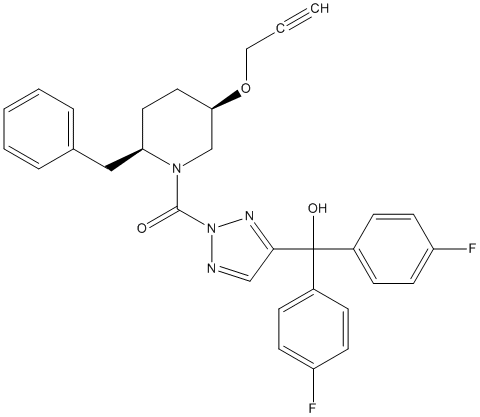DH376
General
Type : Piperidine,Triazol,Urea derivative
Chemical_Nomenclature : [(2R,5R)-2-benzyl-5-prop-2-ynoxypiperidin-1-yl]-[4-[bis(4-fluorophenyl)-hydroxymethyl]triazol-2-yl]methanone
Canonical SMILES : C#CCOC1CCC(N(C1)C(=O)N2N=CC(=N2)C(C3=CC=C(C=C3)F)(C4=CC=C(C=C4)F)O)CC5=CC=CC=C5
InChI : InChI=1S\/C31H28F2N4O3\/c1-2-18-40-28-17-16-27(19-22-6-4-3-5-7-22)36(21-28)30(38)37-34-20-29(35-37)31(39,23-8-12-25(32)13-9-23)24-10-14-26(33)15-11-24\/h1,3-15,20,27-28,39H,16-19,21H2\/t27-,28-\/m1\/s1
InChIKey : GVLOFRPVRYAFKI-VSGBNLITSA-N
Other name(s) : CHEMBL3895863,DH-376,inhibitor 38,SCHEMBL18921266,GTPL10244,BDBM50211257
MW : 542.6
Formula : C31H28F2N4O3
CAS_number : 1848233-57-7
PubChem : 129188688
UniChem : GVLOFRPVRYAFKI-VSGBNLITSA-N
IUPHAR :
Wikipedia :

Target
Families : DH376 ligand of proteins in family: Lipase_3
Stucture :
Protein : human-DAGLA || human-DAGLB
References (4)
| Title : Inhibition of diacylglycerol lipase beta modulates lipid and endocannabinoid levels in the ex vivo human placenta - Berger_2023_Front.Endocrinol.(Lausanne)_14_1092024 |
| Author(s) : Berger N , van der Wel T , Hirschmugl B , Baernthaler T , Gindlhuber J , Fawzy N , Eichmann T , Birner-Gruenberger R , Zimmermann R , van der Stelt M , Wadsack C |
| Ref : Front Endocrinol (Lausanne) , 14 :1092024 , 2023 |
| Abstract : Berger_2023_Front.Endocrinol.(Lausanne)_14_1092024 |
| ESTHER : Berger_2023_Front.Endocrinol.(Lausanne)_14_1092024 |
| PubMedSearch : Berger_2023_Front.Endocrinol.(Lausanne)_14_1092024 |
| PubMedID: 36864832 |
| Gene_locus related to this paper: human-DAGLA , human-DAGLB |
| Title : Mapping in vivo target interaction profiles of covalent inhibitors using chemical proteomics with label-free quantification - van Rooden_2018_Nat.Protoc_13_752 |
| Author(s) : van Rooden EJ , Florea BI , Deng H , Baggelaar MP , van Esbroeck ACM , Zhou J , Overkleeft HS , van der Stelt M |
| Ref : Nat Protoc , 13 :752 , 2018 |
| Abstract : van Rooden_2018_Nat.Protoc_13_752 |
| ESTHER : van Rooden_2018_Nat.Protoc_13_752 |
| PubMedSearch : van Rooden_2018_Nat.Protoc_13_752 |
| PubMedID: 29565900 |
| Title : Triazole Ureas Act as Diacylglycerol Lipase Inhibitors and Prevent Fasting-Induced Refeeding - Deng_2017_J.Med.Chem_60_428 |
| Author(s) : Deng H , Kooijman S , van den Nieuwendijk AM , Ogasawara D , van der Wel T , van Dalen F , Baggelaar MP , Janssen FJ , van den Berg RJ , den Dulk H , Cravatt BF , Overkleeft HS , Rensen PC , van der Stelt M |
| Ref : Journal of Medicinal Chemistry , 60 :428 , 2017 |
| Abstract : Deng_2017_J.Med.Chem_60_428 |
| ESTHER : Deng_2017_J.Med.Chem_60_428 |
| PubMedSearch : Deng_2017_J.Med.Chem_60_428 |
| PubMedID: 27992221 |
| Title : Rapid and profound rewiring of brain lipid signaling networks by acute diacylglycerol lipase inhibition - Ogasawara_2016_Proc.Natl.Acad.Sci.U.S.A_113_26 |
| Author(s) : Ogasawara D , Deng H , Viader A , Baggelaar MP , Breman A , den Dulk H , van den Nieuwendijk AM , Soethoudt M , van der Wel T , Zhou J , Overkleeft HS , Sanchez-Alavez M , Mori S , Nguyen W , Conti B , Liu X , Chen Y , Liu QS , Cravatt BF , van der Stelt M |
| Ref : Proc Natl Acad Sci U S A , 113 :26 , 2016 |
| Abstract : Ogasawara_2016_Proc.Natl.Acad.Sci.U.S.A_113_26 |
| ESTHER : Ogasawara_2016_Proc.Natl.Acad.Sci.U.S.A_113_26 |
| PubMedSearch : Ogasawara_2016_Proc.Natl.Acad.Sci.U.S.A_113_26 |
| PubMedID: 26668358 |
| Gene_locus related to this paper: human-DAGLA , human-DAGLB |